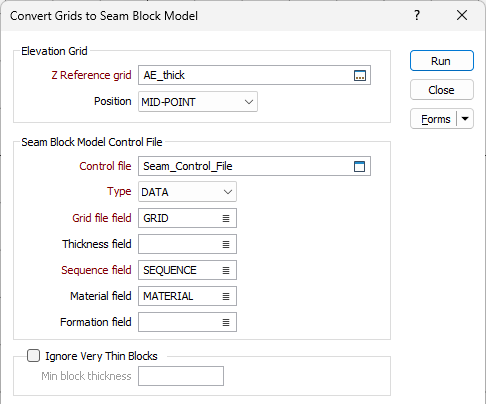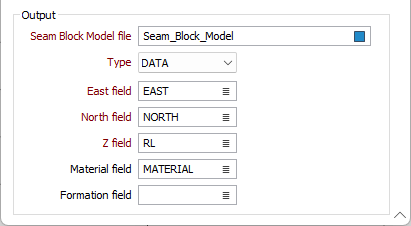Create from Multiple Seams
![]()
This topic refers to seams. However there will be cases when plies, rather than seams, are being modelled.
Elevation Grid
Double-click (F3) to select an input reference grid. A single elevation grid is needed to define the actual Z values for one of the seams. The Z values for all other layers are calculated from this Reference Grid by adding or subtracting the appropriate combination of thicknesses.
Position
Select an option which defines the Z position of the Reference Grid. The Reference Grid can be located anywhere in the sequence of layers and may contain Z values which define the ROOF, FLOOR, or MID-POINT of a particular seam. MID-POINT is the default.
Unless you are using an earlier version Control file, the Reference Grid is expected to have a sequence number of zero, with positive sequence numbers for the layers above it and negative sequence numbers for the layers below it.
If the input Control file was generated in an earlier release and has no zero seam, select the FROM SEQUENCE option to apply the old logic to the sequence numbers in the file.
Seam Block Model Control File
The function takes the individual thickness grids and generates a single block model file representing the seams. As well as the thickness grids, constant thickness layers can be included in the sequence. All of this information is defined in the Seam Block Model Control File.
The records in the Control file can be in any order. The function will sort the records, based on the Sequence number, before creating the Seam Block Model file.
A Seam Block Model Control File can be generated using the Stratigraphic | Grid Create | Control File function. The formations in the Control file must be constant. A Seam Block Model should be generated for each formation in a stratigraphy.
Grid File field
The Grid file field contains the name of a Thickness grid. The .GRD extension is optional. If the Grid file is not found, the function will use the value in the Thickness field for that sequence layer.
Thickness and Sequence fields
Double-click (F3) to select the name of the fields in which the Thickness values and Sequence numbers are stored.
The Sequence field defines the order of the layers. The Reference Grid Gaps in the sequence are acceptable. So the sequence 4, 3, 2, 1, 0, -1, -2 is equivalent to 12, 9, 6, 1, 0, -1, -5.
Material and Formation fields
You have the option of writing the Material field and Formation field codes to the output Seam Block Model file. The Material field is a field containing both coal (seams or plies) and interburden (partings) and/or overburden codes.
The Formation field contains the values that identify each formation. A Formation is a group of seams, modelled independently.
Ignore very thin blocks
Minimum block thickness
If the Ignore very thin blocks check box is selected and a Minimum block thickness is specified, those blocks with a thickness which is less than the specified minimum will not be written to the output Seam Block Model file.
However, those blocks with a thickness less than the Minimum block thickness, will have their thickness added evenly to the block above and the block below (in the column). This maintains the integrity of the column.
If a value is entered here the process will ignore blocks with a thickness which is less than the specified value. The field has at least two decimal places, however, if the specified minimum thickness is, for example, 0.0001, the number of decimals will be four. If not specified, the default minimum thickness is 0.001.

Output
Seam Block Model File
Enter or double-click (F3) to select the name of the Seam Block Model file that will be created as a result of the conversion process.

The file format of a Seam Block Model file is the same as that of an Ore Block Model. In a Seam Block Model, the East and North dimensions of the blocks must be regular. However, the Z dimension of the blocks will vary, since they represent the thickness of the seams.
The Seam Block Model file is generated on a column by column basis. Any Thickness grid cell with a value less than or equal to 0 is ignored. Subsequent grids will still be processed for this column. Any Thickness grid cell with a null (undefined) value will stop the processing, in either the upward or downward direction, for that column.
East, North and Z fields
Enter or double-click to select the name of the coordinate fields in the Seam Block Model file.
Material and Formation fields
(Optional) The content of the Material and Formation fields in the Seam Block Model Control file (see above) are written to the fields you specify here. These fields are normally used to identify the seam represented by each block, and the formation each seam belongs to.
Forms
Click the Forms button to select and open a saved form set, or if a form set has been loaded, save the current form set.
Run
Finally, click Run to generate the Seam Block Model file.